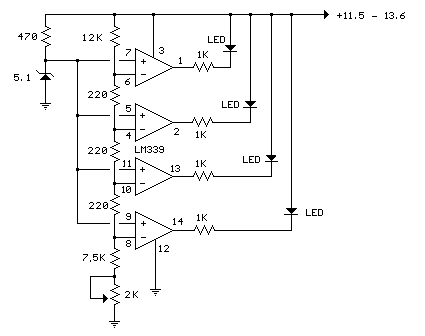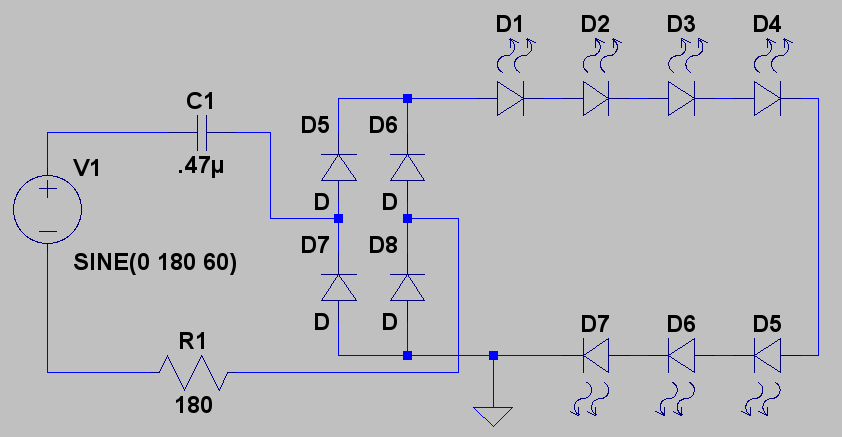
LIGHT METER WITH LED READOUT

The phototransistor Q1 (Radio Shack 276-130) activates a voltage change across resistor R2, which is then amplified by an operational amplifier (op-amp). The output from the op-amp drives an array of five LEDs, creating a bar graph voltage indicator. To achieve the highest sensitivity, resistor R3 should be adjusted initially by turning off the room lights and rotating the resistor until LED 1 just stops glowing. As the light intensity on the sensor increases gradually, the LEDs illuminate sequentially from the lowest to the highest, remaining lit until all five are activated. Alternative light sensors such as solar cells or selenium cells can be utilized in place of the phototransistor.
The circuit design incorporates a phototransistor (Q1), which serves as the primary light sensor. When illuminated, Q1 generates a current that flows through resistor R2. This current induces a voltage drop across R2, which is proportional to the intensity of the incident light. The voltage change across R2 is fed into the non-inverting input of the operational amplifier, which amplifies the signal. The gain of the op-amp can be configured by selecting appropriate resistor values in the feedback loop.
Resistor R3 plays a critical role in calibrating the circuit's sensitivity. By adjusting R3, the threshold at which the first LED lights up can be finely tuned. This adjustment ensures that LED 1 only turns on when ambient light levels are sufficiently low, allowing for precise control over the activation of the LED array as light levels change.
The five LEDs are connected to the output of the op-amp, arranged in a manner that allows them to light up in sequence. This arrangement provides a visual representation of the light intensity detected by the phototransistor. The circuit is designed to ensure that each LED remains lit once it has been activated, creating a clear and intuitive bar graph display.
In addition to the phototransistor, the circuit can accommodate alternative light sensors, such as solar cells or selenium cells. These alternatives may offer different sensitivity characteristics or response times, allowing for flexibility in application depending on the specific requirements of the project.
This electronic schematic is particularly useful in applications requiring visual feedback based on light levels, such as ambient light monitoring, light-sensitive alarms, or educational demonstrations of photonic principles. The simplicity of the design allows for easy replication and modification, making it a valuable project for both novice and experienced electronics enthusiasts.Light onphototransistorQ1 (Radio Shack 276-130) produces voltage change across R2 for amplification by opamp whose output drives array fiveLEDs forming bar graph voltage indicator. Adjust R3 initially for highest sensitivity by tuming off room lights and rotating until LED 1 just stops glowing.
Now, as light is gradually increased on sensor, LEDs come on one by one in upward sequence and stay on until all five are lit. Solar cells or selenium cells can be used in place of phototransistor. -F. M. Mims, "Opto-electronic Projects, Vol. 1, " Radio Shack, Fort Worth, TX, 1977, 2nd Ed. , p 85-93. 🔗 External reference
The circuit design incorporates a phototransistor (Q1), which serves as the primary light sensor. When illuminated, Q1 generates a current that flows through resistor R2. This current induces a voltage drop across R2, which is proportional to the intensity of the incident light. The voltage change across R2 is fed into the non-inverting input of the operational amplifier, which amplifies the signal. The gain of the op-amp can be configured by selecting appropriate resistor values in the feedback loop.
Resistor R3 plays a critical role in calibrating the circuit's sensitivity. By adjusting R3, the threshold at which the first LED lights up can be finely tuned. This adjustment ensures that LED 1 only turns on when ambient light levels are sufficiently low, allowing for precise control over the activation of the LED array as light levels change.
The five LEDs are connected to the output of the op-amp, arranged in a manner that allows them to light up in sequence. This arrangement provides a visual representation of the light intensity detected by the phototransistor. The circuit is designed to ensure that each LED remains lit once it has been activated, creating a clear and intuitive bar graph display.
In addition to the phototransistor, the circuit can accommodate alternative light sensors, such as solar cells or selenium cells. These alternatives may offer different sensitivity characteristics or response times, allowing for flexibility in application depending on the specific requirements of the project.
This electronic schematic is particularly useful in applications requiring visual feedback based on light levels, such as ambient light monitoring, light-sensitive alarms, or educational demonstrations of photonic principles. The simplicity of the design allows for easy replication and modification, making it a valuable project for both novice and experienced electronics enthusiasts.Light onphototransistorQ1 (Radio Shack 276-130) produces voltage change across R2 for amplification by opamp whose output drives array fiveLEDs forming bar graph voltage indicator. Adjust R3 initially for highest sensitivity by tuming off room lights and rotating until LED 1 just stops glowing.
Now, as light is gradually increased on sensor, LEDs come on one by one in upward sequence and stay on until all five are lit. Solar cells or selenium cells can be used in place of phototransistor. -F. M. Mims, "Opto-electronic Projects, Vol. 1, " Radio Shack, Fort Worth, TX, 1977, 2nd Ed. , p 85-93. 🔗 External reference





